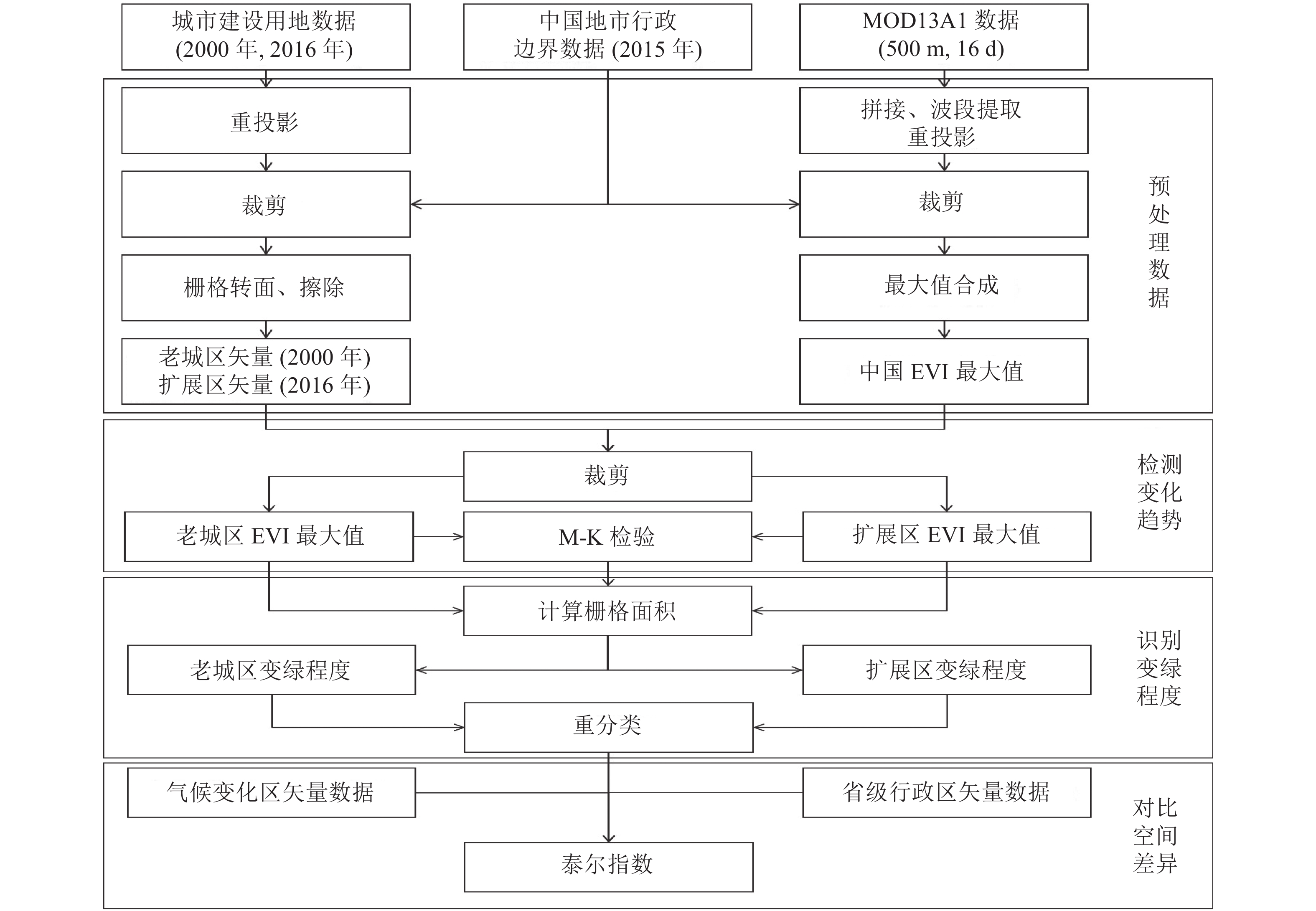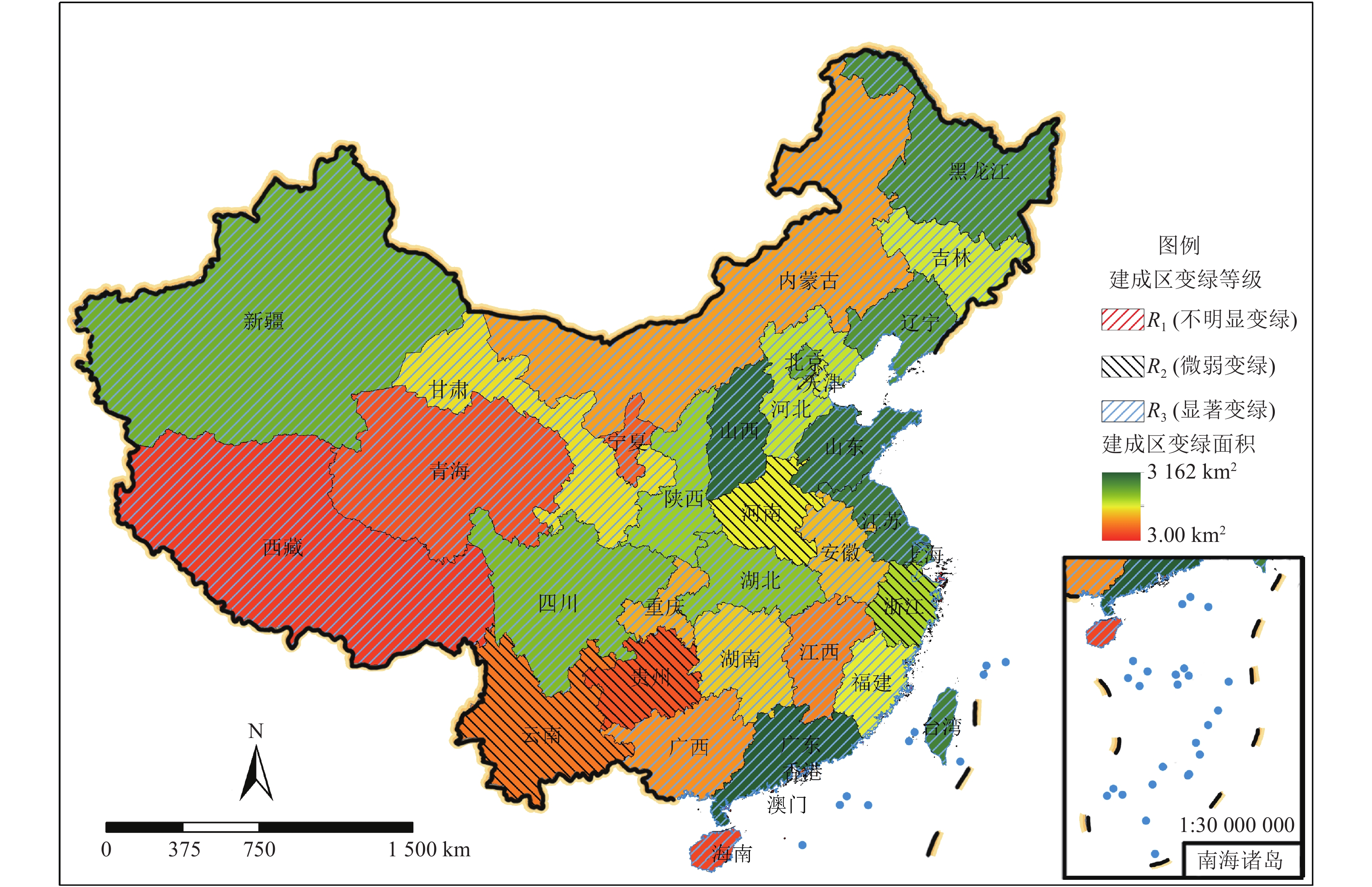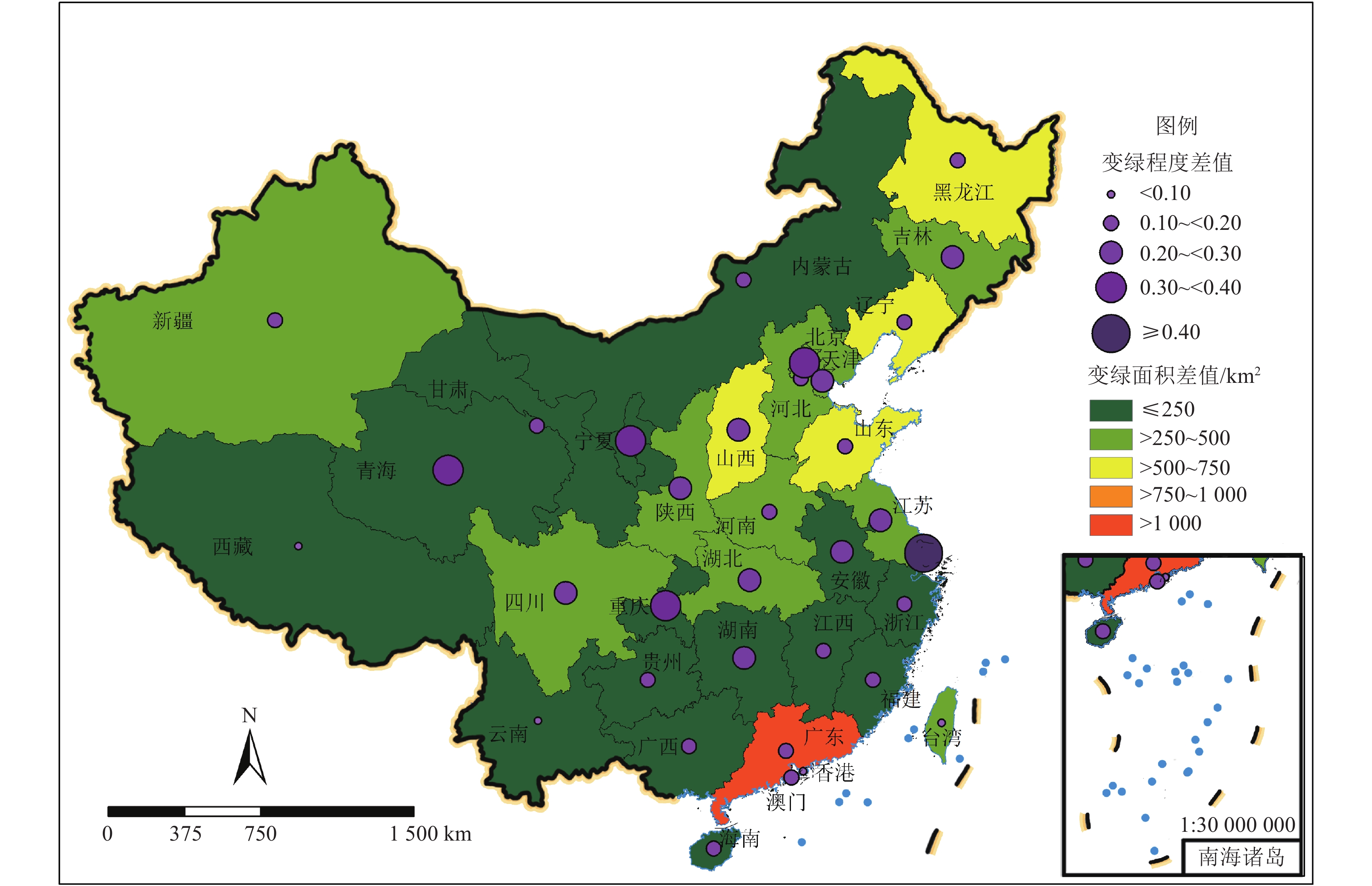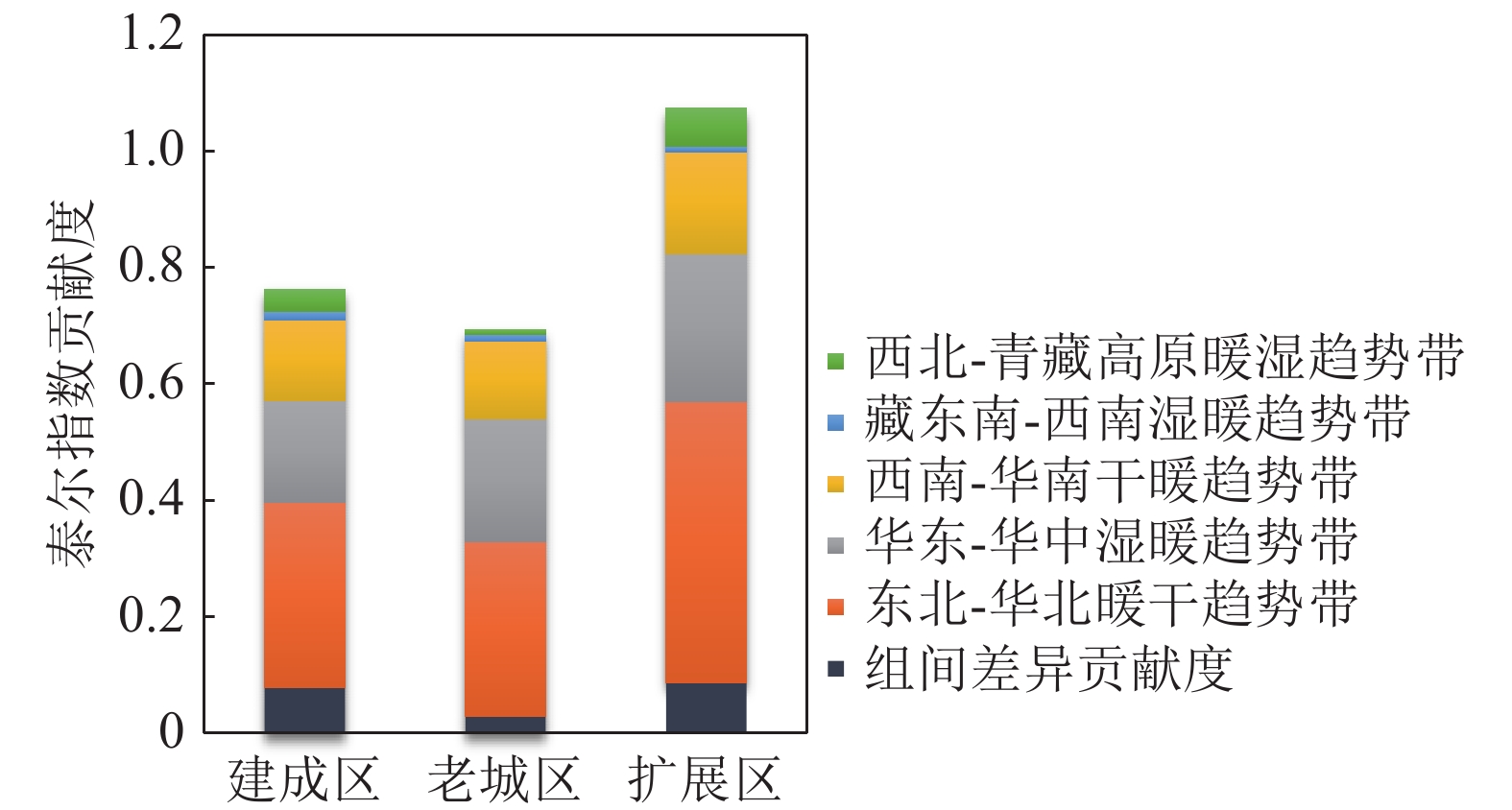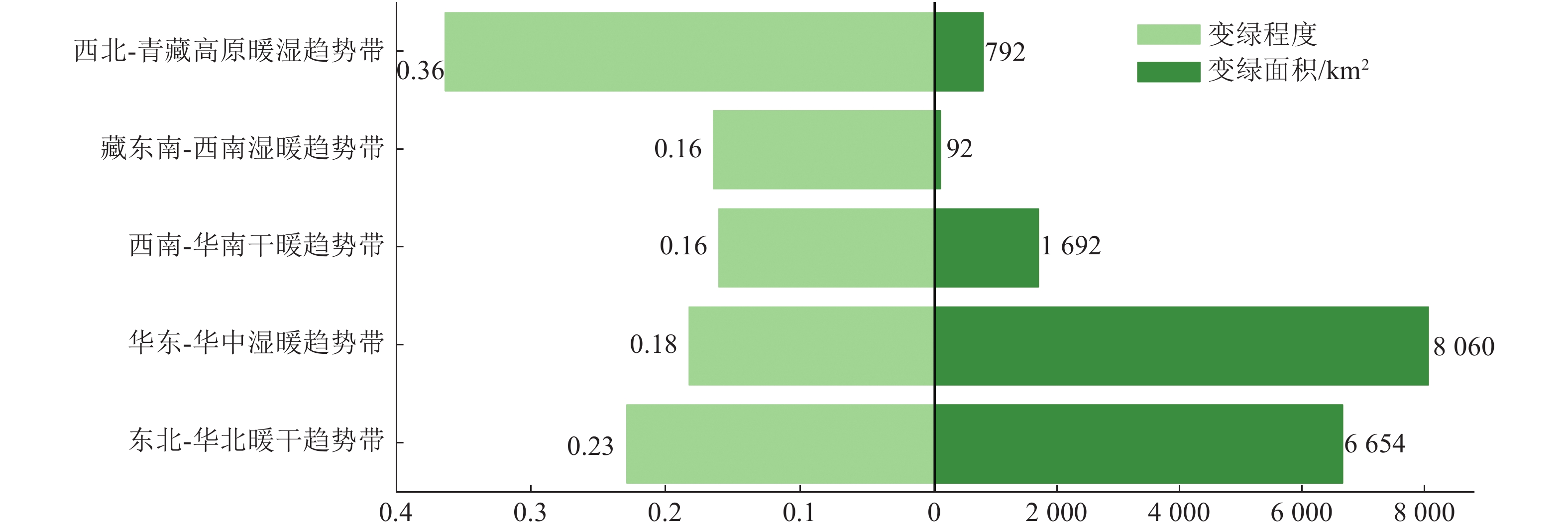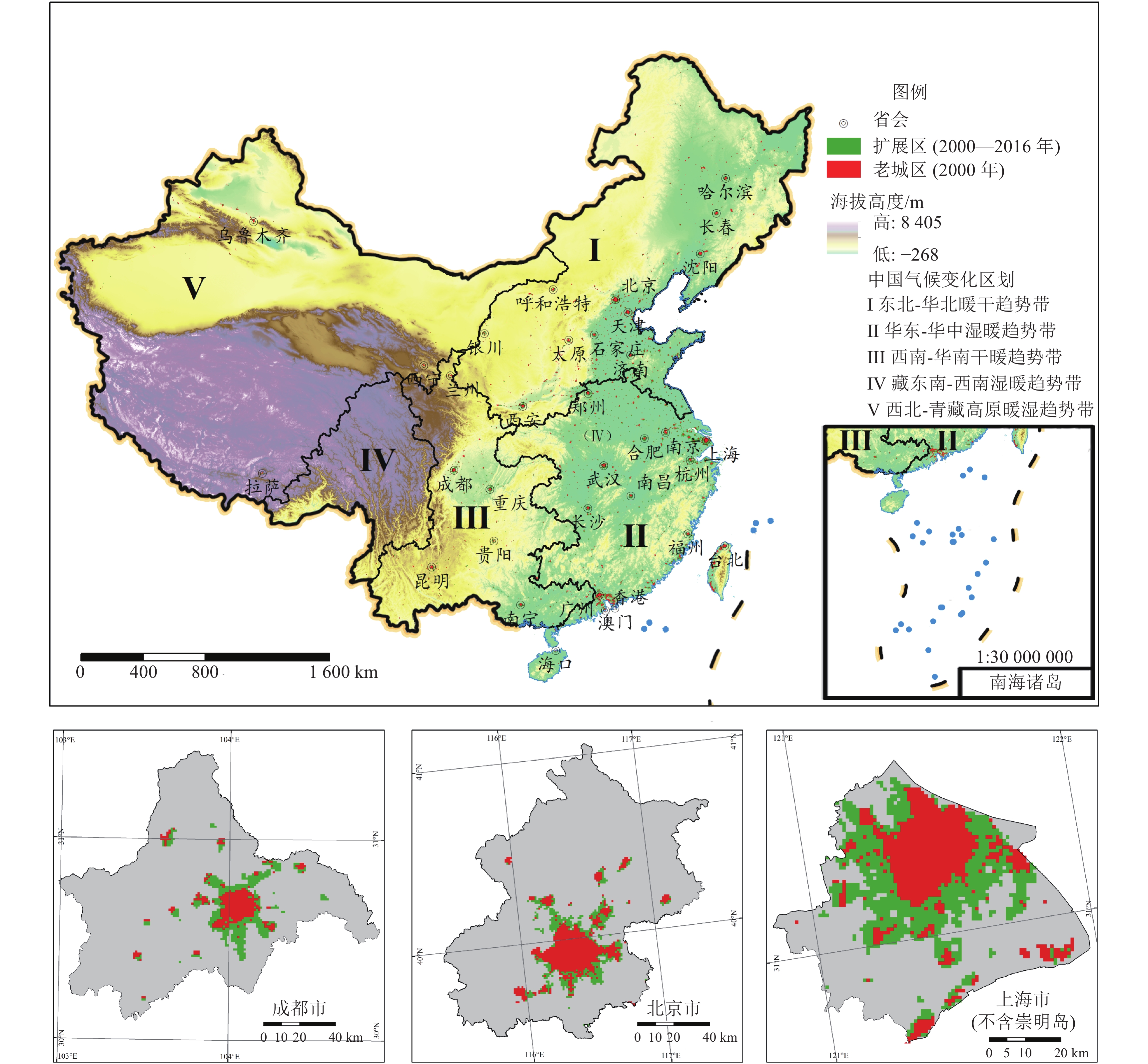Identification and comparative analysis of vegetation greening trends in built-up areas in China
-
摘要: 基于2001—2020年增强型植被指数(enhanced vegetation index,EVI),利用曼-肯德尔(Mann-Kendall,M-K)检验与泰尔指数,分析中国老城区(2000年已成为建成区)与扩展区(2000—2016年新增建成区)的植被变绿趋势,以及在不同气候变化区植被变绿趋势的差异.研究发现:1)中国约20%(17 290 km2)的建成区植被呈显著变绿趋势.其中华东—华中湿暖趋势带的建成区植被变绿面积,占中国建成区植被总变绿面积的46.61%,30个省级行政区10%以上的建成区植被呈显著变绿趋势.2)在老城区与扩展区的植被变绿趋势的对比上,老城区的植被显著变绿,扩展区的植被微弱变绿,老城区的植被变绿面积(13 474 km2)是扩展区植被变绿面积(3 818 km2)的3.5倍多.不同气候变化区的植被变绿趋势差异表明,需要因地制宜地应对气候变化对城市建成区植被生长的影响,重视西南—华南干暖趋势带的供水设施建设,保证植被的生长需求.Abstract: Built-up areas are main places for human activities.Currently, we still lack a clear understanding of the spatiotemporal differences in greening trends between old and new urban areas within cities across China.Enhanced vegetation index from 2001-2020 was used in this study to analyze differences in greening trends between old and expanding built-up areas in China by Mann-Kendall test and Theil index.Approximately 20% (17 290 km2) of built-up areas in China were found to exhibit a significant greening trend; the East China-Central China wet-warm zone contributed 46.6% of the total greening area in China; more than 10% of the built-up areas in 30 provinces showed a significant greening trend.A comparison between older and expanding built-up areas found that older areas had become significantly greener, whereas the more recently expanded areas had become slightly greener; the greening area in older areas(13 474 km2) was 3.5 times that in the expanding areas(3 818 km2) .Differences in the greening trend of vegetation in different climate change zones indicated that it is necessary to respond to the impact of climate change on the growth of vegetation in urban built-up areas locally, and pay attention to water supply facilities in the Southwest-South China dry-warm zone to meet the demand of vegetation growth.
-
Keywords:
- urban greening /
- urban expansion /
- climate change /
- urban vegetation /
- urban sustainability
-
0 引言
城市植被是城市景观的重要组成部分,既具备重要的生态效益(如改善空气质量、涵养水源、调节城市气候[1-3]),又可以改善心血管疾病、降低犯罪风险、提升生态美学,从而增加社会福祉,提高居民的生活水平[4-7].联合国可持续发展峰会2017年正式通过的《2030年可持续发展议程(A/RES/313/2020)》要求,到2030年向所有人普遍提供安全、包容、便利、绿色的公共空间,建设可持续的城市和人类住区[8].城市绿地建设在生态环境和宜居城市建设中的重要性日益凸显[9].
改革开放以来,我国进入城镇化高速发展阶段,城镇化率从1978年的17.92%提升到2020年的63.89%[10-11].过快的城市发展对城市绿地建设提出挑战,城市发展带来的土壤、空气、粉尘污染等问题限制了植被的生长和存活,密集的高楼建筑影响植被的物种丰富度[12-13].城市绿地作为生态系统、陆地碳汇不容忽视的部分,在城镇化发展中受到越来越多的重视[14-17].
目前,关于城市植被动态研究的方法主要有2种:1)基于遥感产品.由于遥感产品时空分辨率高、时间序列长、覆盖范围广,因此被广泛应用于长时间序列的动态评估.Chen等[18]依据2000—2017年的叶面积指数(leaf area index, LAI)产品发现:中国和印度大城市的植被变绿呈现显著增长趋势;北京、天津等大城市植被变绿区域呈“煎蛋状”.Richards等[19]通过研究111个东南亚城市的植被变绿趋势发现:1990—2018年老城区植被先变棕后显著变绿,扩展区植被显著变棕,非建成区植被显著变绿;人口密度与植被变绿面积在空间上呈负相关、人均GDP与植被变绿面积呈正相关.Hong等[20]基于增强型植被指数(enhanced vegetation index, EVI)开发的绿色指数(green index, GI),从数量-稳定性-平衡3方面评估全国建成区的植被变绿趋势,得出中国建成区的平均植被变绿趋势呈现V形发展,GI遵从东—中—西递减规律.Wu等[21]通过构建区域绿度动态指数(regional greenness dynamic index, RGDI)发现,2010—2019年城市65%的老城区植被呈现变绿趋势.2)基于资料统计.依据中华人民共和国住房和城乡建设部统一规定的绿化指标,如绿地率等,进行不同城市和区域之间的纵向和横向对比分析[22].邢琳琳[23]通过离差系数对比1990—2012年我国建成区的绿地率与人均公园面积增长率探究绿地增长的协调性,结果发现中国中部、西部绿地增长高度失调,东部和东北中度失调,绿地率增长率滞后于人均公园面积增长率;李方正等[24]比较了2014年我国7大区域的建成区绿地率以及人均公园面积的均值等指标,得出我国绿化覆盖率差异呈现“北高西低,中、东居中”的结论;张金[22]构建了以地级及以上城市为研究对象的绿化覆盖率综合评价指标体系,比较了东、中、西3大经济分区和8大气候分区之间绿化覆盖率的差异.
无论是基于遥感还是基于统计资料,现有研究大多关注了中国城市之间的植被变绿趋势.对于城市内部,特别是老城区与扩展区之间植被变绿趋势的时空差异研究还非常少.本文依据中国城市建成区数据,采用2001—2020年的EVI产品,通过 M-K法,运用空间显式的方法,研究自21世纪初以来,中国城市建成区的植被变绿趋势的总体特征,以及在不同气候变化区的老城区与扩展区的植被变绿趋势时空差异,探究在全球变暖背景下如何因地制宜缩小区域间和区域内的植被变绿趋势差异.
1 研究区概况与数据来源
1.1 研究区概况
研究区为中国34个省级行政区(图1).中国地势自西向东可构成三级阶梯,三级阶梯地形分别以高山、高原,山地、高原、盆地、平原和丘陵为主,平均海拔高度分别>4 000 、1 000~2 000 、<500 m[25].依据1961—2010年气温和降水量的变化趋势值,中国可划分为5个气候变化区[26].其中:西北-青藏高原区与东北-华北区均为气温快速上升带;华东-华中区与藏东南-西南区为降水快速上升、气温缓慢上升带;西南-华南区为气温快速上升、降水快速下降带[26].
2020年我国城镇人口比例达到63.89%,城镇化水平仍在上升,列前3位城市分别为上海、北京和天津[27].全国城市绿地面积为33 122.45 km2,建成区绿化覆盖率达42.10%.其中:北京覆盖率最高,达49.00%;青海最低,仅有35.90%[11].1992—2016年,中国城市用地面积增长了72 182 km2,增长率为20.83%,占亚洲城市用地增长面积的50%[28].
1.2 数据来源
相较于归一化植被指数(normalized difference vegetation index, NDVI),因计算式缺陷导致的植被旺盛期易饱和、没有考虑植被冠层背景影响,以及大气校正有限难以消除气溶胶的消减作用等问题[29-30],EVI对高植被覆盖区具有较高敏感性,受土壤背景影响和大气干扰低等特点,可以更好反映植被分布的空间异质性[31],因此本文选用EVI数据.EVI数据源于美国国家航空航天局USGS官网(http://earthquake.usgs.gov/)的MOD13A1产品[32].产品经过大气校正处理,依据低云、低视角和最大值的标准,从16 d所采集信息中选择最佳可用像素值,影像数据时间序列为2001—2020年,时空分辨率为16 d、500 m.
本文所指的城市建成区是指不透水面(如道路、居民楼和机场等)占主导的土地[33].城市建成区数据源于He等[28]利用夜间灯光(nighttime light, NTL)、NDVI以及陆地表面温度(land surface temperature, LST)等多源遥感数据提取得到的1992—2016年全球建成区数据.该数据集总体平均精度达90.9%,其中北京地区总体精度达93.75%,Kappa为0.62,准确性较高,已被广泛使用于全球和区域的城市建成区动态分析[34-35].本文将2000年前就已经存在的建成区定义为老城区,2000—2016年建成区的增长区域为扩展区,空间分辨率为1 km.
中国气候变化区划数据由史培军等[26]根据1961—2010年50年的气温、降水变化趋势值划分得到.相较于传统的气候状态区划,气候变化区划更能反映气候变化的区域差异与所带来的环境风险,更适应气候变化研究的需求,目前已被广泛用于研究[36-37].本文采用气候变化一级区划进行区域对比,能够较好地体现在全球气候变化速率不断加快的背景下,城市建成区的植被变绿趋势的空间差异.
省、市级数据源于中科院资源环境科学数据中心(http://www.resdc.cn/).县级矢量数据源于第6次全国人口普查与中国气候变化二级区划县级行政单元.以上均采用WGS84地理坐标系与Albers投影(25°, 47°, 105°).
2 研究方法
以中国建成区为研究对象,通过M-K检验对全国城市建成区的植被进行长时间序列分析,揭示2000年以来中国城市建成区内部的植被变绿趋势的总体特征,并对比过去20年中国不同气候变化区和省际的老城区与扩展区植被变绿趋势演变的空间分布差异,研究流程见图2.
2.1 预处理数据
基于中分辨率成像光谱仪(moderate-resolution imaging spectroradiometer, MODIS)影像和He等[28]提取的建成区数据,分别获取中国老城区与扩展区2001—2020年的逐年EVI最大值(maximum value of EVI , EVImax)栅格数据.中国行政区共由23景MODIS影像覆盖.1)利用MODIS软件(MODIS reprojection tool,MRT)对同期影像进行拼接、EVI波段提取与重投影;对于时段空缺的影像,如A2020097,将前后2个时期(A2020081和A2020113)的影像进行均值合成,填补数据.2)采用最大值合成(maximum value composite,MVC)处理数据,降低植被物候和外部噪声影响,最后获得20幅空间分辨率为500 m的全国EVImax栅格数据[38].3)通过掩膜和要素转换,获得2000和2016年中国的建成区矢量数据;其中,定义2000年的建成区为老城区,2000—2016年建成区的增长区域为扩展区.4)用建成区数据裁剪全国EVImax栅格数据,获得中国老城区和扩展区的逐年EVImax栅格数据.
2.2 检验植被指数的变化趋势
研究建成区EVI的变化趋势,参考Hong等[20]的研究,采用M-K检验.该检验不要求样本遵从一定的分布,可以检验时间序列变化趋势(无明显趋势(稳定)、趋势上升、趋势下降),并判断时间序列是否发生突变[38-39].由于本文研究城市建成区的植被变绿趋势,因此仅考虑检验统计量>1.96(置信水平为95%)的情况,即像元的EVI存在显著增大趋势,可以认为该像元是显著变绿像元.
2.3 计算变绿程度
探究中国城市建成区植被的实际变绿情况,本文参考Sun等[38]对建成区变绿程度的定义,变绿程度(Rgreen)公式为
$$ {R}_{{\rm{green}}{老}}=\frac{{S}_{{老}}^{\alpha }}{{S}_{{老}}^{{\rm{all}}}}\text{,} $$ (1) $$ {R}_{{\rm{green}}{扩}}=\frac{{S}_{{扩}}^{\alpha }}{{S}_{{扩}}^{{\rm{all}}}}\text{,} $$ (2) 式中:
${{S}}_{\mathrm{老}}^{{\rm{all}}}\mathrm{、}{{S}}_{\mathrm{扩}}^{{\rm{all}}}$ 分别为老城区与扩展区的建成区面积;${{S}}_{\mathrm{老}}^{\alpha }\mathrm{、}{{S}}_{\mathrm{扩}}^{\alpha }$ 分别为老城区与扩展区2001—2020年EVImax变化趋势通过M-K检验的像元面积.根据已有研究,为体现建成区植被变绿趋势的空间分布格局,可将变绿程度
${R}_{{\rm{green}}}$ 分为3个等级[38]:$$R=\left\{\begin{aligned} &R_1,\quad\quad\quad{R}_{{\rm{green}}}\leqslant 0.01,\\ &R_2,\quad0.01{ < R}_{{\rm{green}}}\leqslant 0.1,\\ &R_3,\quad\quad\quad{R}_{{\rm{green}}} > 0.1,\end{aligned}\right. $$ (3) 式中
$R_1$ 为不明显变绿,$R_2$ 为微弱变绿,$R_3$ 为显著变绿.2.4 对比城市变绿差异
为探究中国不同气候变化区建成区变绿程度的差异,本研究采用泰尔指数进行分析.泰尔指数可用以测度数据分布的差异性或不均衡性,包括区域间与区域内2种差异[40].泰尔指数越小,差异越小,反之亦然.
3 结果分析
3.1 中国建成区变绿的一般特征
2001—2020年,中国建成区植被总变绿面积为17290 km2.变绿程度为0.20,植被呈显著变绿趋势,表明过去20年中国有20%的城市建成区植被经历了显著变绿的过程(表1).
表 1 不同气候变化区建成区植被变绿程度及显著变绿面积气候变化区 变绿面积/km2 变绿面积占比/% 变绿程度R Ⅰ 6654 38.49 0.23 Ⅱ 8060 46.61 0.18 Ⅲ 1692 9.79 0.16 Ⅳ 92 0.53 0.36 Ⅴ 792 4.58 0.16 在气候变化区尺度上(表1),就建成区的变绿面积而言,华东-华中区与东北-华北区的建成区变绿面积远远超过其他气候变化区,其变绿面积分别为8 060 和6 654 km2,分别占中国建成区总变绿面积的46.61%和38.49%.换句话说,华东-华中区与东北-华北区贡献了中国85%以上的变绿面积.其余3个气候变化区的建成区变绿面积贡献度较小,仅占中国建成区总变绿面积的14.90%.就建成区的变绿程度而言,5个气候变化区的建成区变绿程度均>0.10,植被呈显著变绿趋势.其中,藏东南-西南区的建成区变绿面积虽然最小(92 km2),但变绿程度最大,为0.36,即该地区超过1/3的建成区植被在过去20年显著变绿.这意味着该气候变化区内的城市重视绿地建设.西南-华南区的建成区变绿程度最低,变绿程度仅为0.16,说明该气候变化区内城市绿地建设力度相对较弱.
在省级尺度上(图3),就建成区的变绿面积而言,广东远超其他省份,其建成区变绿面积为3 162 km2,占中国建成区总变绿面积的17.9%;山西以1 103 km2的变绿面积紧随其后,占6.25%;西藏与澳门的建成区变绿面积最低,分别为22和3 km2,共占中国建成区总变绿面积的0.14%.就建成区的变绿程度而言,中国30个省级行政区的建成区变绿程度R均>0.10,即植被显著变绿.其中,香港、甘肃和青海的建成区变绿面积虽相对较小,但变绿程度位居前三,R均>0.40,即40%以上的建成区植被显著变绿.这意味着香港、甘肃、青海的城市绿地建设得到较好发展.河南、浙江、贵州、云南4省的建成区植被微弱变绿,其中云南的建成区变绿程度最低,变绿程度仅为0.07.
3.2 老城区与扩展区的植被变绿趋势对比
从整体看,老城区的植被变绿趋势明显强于扩展区.就变绿面积而言,扩展区的变绿面积仅为3 818 km2,老城区的变绿面积为13 474 km2,约为扩展区变绿面积的3.5倍,占中国建成区总变绿面积的77.92%.就变绿程度而言,全国建成区的平均变绿程度为0.20,老城区的变绿程度为0.31,即近1/3的老城区植被呈显著变绿趋势;扩展区的变绿程度为0.10,植被呈微弱变绿趋势(表2).
表 2 不同气候变化区内老城区和扩展区植被变绿趋势对比气候变化区 老城区 扩展区 老城区与扩展区差值 S老/km2 (S老/S全老)/% R老 S扩/km2 (S扩/S全扩)/% R扩 (S老 − S扩)/km2 R老 − R扩 Ⅰ 5514 40.93 0.31 1140 29.88 0.10 4374 0.21 Ⅱ 6017 44.66 0.29 2043 53.52 0.09 3974 0.20 Ⅲ 1275 9.46 0.26 418 10.94 0.07 857 0.19 Ⅳ 82 0.60 0.24 11 0.28 0.05 71 0.19 Ⅴ 586 4.35 0.42 206 5.39 0.27 380 0.15 注:S全老和S 全扩分别表示全国的老城区和扩展区显著变绿面积,S老表示老城区显著变绿面积,S扩表示扩展区显著变绿面积;R老表示老城区变绿程度,R扩表示扩展区变绿程度. 在气候变化区尺度上,所有气候变化区的老城区变绿面积和变绿程度均明显高于扩展区,老城区的植被呈显著变绿趋势(表2).就老城区而言,华东-华中区的老城区变绿面积最大,占中国老城区总变绿面积的44.66%;西北-青藏高原区的老城区变绿程度最大,约42%的老城区植被显著变绿;藏东南-西南区的老城区变绿面积和变绿程度最低,分别为82 km2和0.24.就扩展区而言,华东-华中区的扩展区变绿面积最大,贡献了中国扩展区内53.52%的植被变绿面积;除西北-青藏高原区的扩展区变绿程度>0.10、植被呈显著变绿趋势外,其余气候变化区的扩展区变绿程度均≤0.10,扩展区植被呈微弱变绿趋势.
不同气候变化区的老城区与扩展区的变绿面积差值差异较大,变绿程度差值均>0.10.藏东南-西南区的老城区与扩展区变绿面积差值最小,仅为71 km2;东北-华北区的老城区与扩展区变绿面积差值与变绿程度差值均最大,分别为4374 km2和0.21;西北-青藏高原区的老城区与扩展区变绿程度差值最小,仅为0.15.这说明不同气候变化区的老城区绿地建设均显著强于扩展区.
在省级尺度上,所有省级行政区的老城区变绿面积和变绿程度均明显强于扩展区,老城区的植被呈显著变绿趋势(图4).就老城区(图4-a)而言,广东的老城区变绿面积远超其他地区,变绿面积为2 220 km2,占中国老城区总变绿面积的16.88%;澳门和西藏的老城区变绿面积最小,分别为15km2和3 km2,占中国老城区总变绿面积的0.13%.所有省级行政区的老城区变绿程度均>0.10,植被呈显著变绿趋势.其中:青海的老城区变绿程度最大,达0.51,即50%以上的老城区植被显著变绿;云南的老城区变绿程度最低,仅为0.11.就扩展区(图4-b)而言,广东、山西、台湾与黑龙江的扩展区变绿面积均>200 km2.其中,广东的扩展区变绿面积最大,为942 km2,贡献了中国扩展区25%的变绿面积.就扩展区变绿程度而言,有14个省级行政区的扩展区植被显著变绿,19个省级行政区的扩展区植被微弱变绿,1个行政区的扩展区植被为不明显变绿.具体来说,香港和甘肃的扩展区变绿程度最高,均有近1/3的扩展区植被呈显著变绿趋势;云南和河南的扩展区变绿程度最低,变绿程度<0.03;澳门的扩展区显著变绿面积为0.
此外,老城区与扩展区的变绿面积差值省际差异同样较大(图5),波动幅度为3~1 279 km2.其中,广东的老城区与扩展区变绿面积差值最大,老城区的变绿面积比扩展区多1 279 km2,是变绿面积差值第2大省山西的2倍.除香港、云南、西藏、台湾外,所有省级行政区的老城区与扩展区变绿程度差值均>0.10,即这些地区老城区的绿地建设明显优于扩展区.上海的老城区与扩展区变绿程度差值最大,为0.40,说明上海扩展区的绿地建设发展水平远不及老城区;台湾的老城区与扩展区变绿程度差值最小,仅为0.01,意味着台湾老城区与扩展区的绿地建设发展水平差距较小.
3.3 气候变化区植被变绿程度差异
在全国尺度,2001—2020年建成区的植被变绿程度在全国分布极其不均衡(表3).具体而言,全国建成区变绿程度的泰尔指数为0.74.其中,老城区变绿程度的泰尔指数为0.68,扩展区变绿程度的泰尔指数为1.08.这说明相比老城区,扩展区的变绿程度在全国分布更加不均衡.
表 3 中国各气候变化区变绿程度泰尔指数气候变化区 建成区 老城区 扩展区 全国 0.74 0.68 1.08 Ⅰ 0.63 0.59 0.95 Ⅱ 0.72 0.70 1.07 Ⅲ 0.90 0.81 1.18 Ⅳ 1.25 1.04 2.02 Ⅴ 0.46 0.81 0.64 在气候变化区尺度,就建成区而言,5大气候变化区的区域内建成区变绿程度分布均呈现较强的不均衡性(表3).其中,藏东南-西南区和西南-华南区的建成区变绿程度泰尔指数高于全国水平,藏东南-西南区的建成区变绿程度泰尔指数最大,为1.25,区域内的建成区变绿程度分布极不均衡.西北-青藏高原区的建成区变绿程度泰尔指数最小,区域内的建成区变绿程度分布最均衡.就老城区而言,仅东北-华北区的老城区变绿程度泰尔指数低于全国水平,为0.59,区域内的老城区变绿程度分布最均衡;藏东南-西南区的老城区变绿程度泰尔指数>1,区域内的老城区变绿程度分布最不均衡.就扩展区而言,除东北-华北区和西北-青藏高原区外,其余气候变化区的扩展区变绿程度泰尔指数均>1,区域内的扩展区变绿程度分布呈现较强的不均衡性.
进一步比较老城区和扩展区2种城市建成区类型下的变绿程度分布不均衡性.在气候变化区尺度,除西北-青藏高原区外,其他气候变化区的区域内建成区变绿程度分布不均衡性均为扩展区强于老城区.藏东南-西南区的老城区与扩展区变绿程度泰尔指数差值最大,区域内的变绿程度分布不均衡性差异最大.
通过比较区域内与区域间差异对总体差异的贡献度可以得出,无论是老城区、扩展区还是建成区,5大气候变化区的区域内差异是造成中国建成区变绿程度分布不均衡的主要原因,东北-华北区的区域内建成区变绿程度分布不均衡是气候变化区的变绿程度出现较大区域内差异的主要原因(图6).
就建成区而言,其变绿程度的区域内与区域间差异对中国建成区变绿程度总体差异的贡献度分别为92.2%和7.8%.在建成区的区域内差异中,东北-华北区的区域内差异贡献度最大,达32.0%;藏东南-西南区的区域内差异贡献度最小.这意味着,中国建成区变绿程度分布的不均衡主要是因为东北-华北区的区域内变绿程度分布不均衡.就老城区而言,其变绿程度区域内与区域间差异对老城区总体差异的贡献度分别为97.0%和3.0%.在老城区的区域内差异中,东北-华北区的区域内差异贡献度最大,达30.0%,贡献了近1/3的中国老城区变绿程度的总体差异;西北-青藏高原区的区域内差异贡献度最小,<1.0%.就扩展区而言,其变绿程度的区域内与区域间差异对扩展区总体差异的贡献度分别为91.0%和9.0%.在扩展区的区域内差异中,东北-华北区的区域内差异贡献度为48.0%,贡献了近50%的扩展区总体差异;藏东南-西南区的区域内差异贡献度最小,仅为9.0%.综合以上数据可知,不同气候变化区的区域内建成区变绿程度分布参差不齐,表明影响区域内部变绿程度的因素更为复杂.
4 讨论
4.1 结果有效性
在数量上,本文最终识别2001—2020年中国建成区内的老城区显著变绿面积为13 474 km2,变绿程度为0.31;扩展区变绿面积为3 818 km2,变绿程度为0.10.这与Wu等[21]识别的中国1990—2019年107个大中城市老城区显著变绿面积为10 667 km2的结果较为接近.由于多数老城区在21世纪前就已经建成,区域内城市的土地利用方式相对稳定、发育程度较高,有能力为居民提供良好的公共服务,增加更多的城市基础设施,如绿地或公园等[38];同时老城区作为城市的核心地带,更加重视生态环境保护.因此在政策引领下,任何新建立的公园、绿地或街道植被的增长都会增加像元的绿度,老城区多呈现显著变绿的趋势[38].扩展区是城市经济发展的象征,是城市化快速发展的标志.自21世纪初中国加入世界贸易组织后,扩展区经历了土地的加速开发和利用[20].出于经济角度,扩展区土地利用和覆盖类型发生大规模转型,大量的植被转换为沥青等不透水面[41-42].尽管政府在城市扩张中更注重环境保护,但破坏现有植被的同时建造新的城市绿地仍会导致扩展区变绿程度普遍降低[41].这与He等[43] “1992—2012年,中国50%以上的扩展区表现出环境退化”、Yang等[41] “1990年—2010年扩大的城市区域整体呈现植被覆盖丧失趋势”的结论相一致.
在区域的变绿趋势上,本文识别建成区变绿面积从大到小依次为:华东-华中区、东北-华北区、西南-华南区、西北-青藏高原区、藏东南-西南区; 变绿程度从大到小依次为:西北-青藏高原区、东北-华北区、华东-华中区、藏东南-西南区、西南-华南区.这与Hong等[20]2001—2018年中国建成区“西部平均绿色覆盖度低于中国中部和东部”的结论一致,但与“平均绿色指数南高北低,东部沿海和西南最高”的结论有所区别.本文认为北方变绿面积与变绿程度均较大,变绿趋势较好;西南的变绿面积虽处于中等水平,但变绿程度最差.这可能是因为2个研究对变绿趋势的评估标准不同,Hong等[20]从“质量、稳定性、均衡性”3个角度进行评估,本文则更侧重变绿的面积与程度.
在区域内与区域间的变绿程度差异对总体差异的贡献度上,本文与Hong等[20]均得到“建成区的区域内差异对中国总体差异的贡献度远大于区域间差异”的结论.气候变化区的区域间变绿程度差异对中国总体差异的贡献度为7.8%,这与Hong等[20] “不同尺度上,区域间差异对总体差异的贡献度呈下降趋势,且贡献度基本均<8.0%”的结论较为一致.
4.2 不同气候变化区对植被变绿的影响
在不同的气候变化区,建成区植被的变绿趋势存在差异(图7).已有研究表明,气候条件决定我国城市变绿的时空格局,而政府管理等人文因素则是重要影响因素,随着经济的发展,气候对城市变绿的影响会逐渐减弱[22, 42].在气候适宜地区,植被受气候条件约束较小,因此人文因素成为影响植被变绿趋势的主要原因[42].东北-华北区与华东-华中区地形平坦,经济发展水平较高,有利于进行城市规划中的绿地建设[20];同时这些地区城市面积大,人口密度较高,宜居城市和可持续发展的要求使得城市的绿化覆盖率维持在一定标准之上,因此植被变绿面积相对较大[44].
在经历暖湿化且气候条件限制植被生长的地区,气温上升有利于中国部分地区植被的生长,气温对植被生长的影响强于降水[45].对于中国北部和青藏高原等年均温较低的地区,气温上升可以增加这些区域的积温,延长植被的生长期,促进植被的生长,变绿程度相比其他气候变化区处于较高水平.同时,降水的增加可以显著地促进我国中西部干旱半干旱地区植被的生长,故湿暖趋势带的植被变绿程度也相对较高.而对于降水减少、气温上升的干暖趋势带,植被生长将会受到极大抑制,因此有必要重视该地区的供水设施建设,保证植被生长的正常水分需求.换言之,全球气候变化会对不同地区城市建成区的植被变绿产生截然不同的影响,故在制定相关城市规划和生态保护措施时需要因地制宜.
本文虽通过对建成区变绿趋势的识别及对比分析获得了初步结论,但仍有可改进之处:1)遥感数据的时空分辨率不足.使用的建成区数据空间分辨率为1 km,EVI影像空间分辨率为500 m,难以准确表征城市内小块、斑状的城市建成区与建成区植被,这种局限在量化西部地区(藏东南-西南和西北-青藏高原)的城市建成区及植被变绿趋势时更为明显.2)采用2016与2000年建成区的区域之差作为扩展区,与研究时间序列(2001—2020年)内的实际建成区扩展区域存在一定差异.3)使用的气候变化区划以县级行政单元为单位,但由于沿海地区城市行政区破碎度较高、与EVI及建成区数据吻合较差,故沿海城市的植被变绿趋势识别存在一定的误差.4)本文仅识别了中国建成区植被变绿趋势的空间分布特征,并未对变绿的驱动因素进行探究.未来可以通过统计年鉴或MODIS产品的气候数据与人为管理数据,采用地理加权回归、地理探测器、相关分析、主成分分析等多种方法,探究驱动因素对建成区变绿趋势的影响.5)本文仅研究了1个时间截面的泰尔指数,并未探究区域差异随时间的演变.后续可以将5 a作为一个时间窗口进行区域差异分析,探究不同气候变化区的区域内与区域间变绿程度差异的时空演变特征.
5 结论
2001—2020年中国建成区的整体变绿程度为0.20,植被呈显著变绿趋势,建成区变绿面积共17 290 km2.华东-华中区的建成区变绿面积最大,贡献了中国建成区总变绿面积的46.61%;西北-青藏高原区的建成区变绿程度最大,老城区与扩展区的变绿程度差值最小,城市绿地建设情况较好.30个省级行政区>10%的建成区植被显著变绿.
在城市内部的对比中,老城区的植被变绿趋势比扩展区显著.总体来说,老城区的植被显著变绿,扩展区的植被微弱变绿,老城区的变绿程度比扩展区高0.21,其变绿面积是扩展区的3.5倍.
最后,需要因地制宜地应对气候变化对城市建成区植被生长的影响.西北-青藏高原暖湿与东北-华北暖干趋势带的变绿程度最高,一定程度上说明气温上升有利于中国部分地区植被的生长.与此同时,要重视西南-华南干暖趋势带的供水设施建设,以保证植被生长的水分需求.
-
表 1 不同气候变化区建成区植被变绿程度及显著变绿面积
气候变化区 变绿面积/km2 变绿面积占比/% 变绿程度R Ⅰ 6654 38.49 0.23 Ⅱ 8060 46.61 0.18 Ⅲ 1692 9.79 0.16 Ⅳ 92 0.53 0.36 Ⅴ 792 4.58 0.16 表 2 不同气候变化区内老城区和扩展区植被变绿趋势对比
气候变化区 老城区 扩展区 老城区与扩展区差值 S老/km2 (S老/S全老)/% R老 S扩/km2 (S扩/S全扩)/% R扩 (S老 − S扩)/km2 R老 − R扩 Ⅰ 5514 40.93 0.31 1140 29.88 0.10 4374 0.21 Ⅱ 6017 44.66 0.29 2043 53.52 0.09 3974 0.20 Ⅲ 1275 9.46 0.26 418 10.94 0.07 857 0.19 Ⅳ 82 0.60 0.24 11 0.28 0.05 71 0.19 Ⅴ 586 4.35 0.42 206 5.39 0.27 380 0.15 注:S全老和S 全扩分别表示全国的老城区和扩展区显著变绿面积,S老表示老城区显著变绿面积,S扩表示扩展区显著变绿面积;R老表示老城区变绿程度,R扩表示扩展区变绿程度. 表 3 中国各气候变化区变绿程度泰尔指数
气候变化区 建成区 老城区 扩展区 全国 0.74 0.68 1.08 Ⅰ 0.63 0.59 0.95 Ⅱ 0.72 0.70 1.07 Ⅲ 0.90 0.81 1.18 Ⅳ 1.25 1.04 2.02 Ⅴ 0.46 0.81 0.64 -
[1] QIU L,LIU F,ZHANG X,et al. The reducing effect of green spaces with different vegetation structure on atmospheric particulate matter concentration in BaoJi city,China[J]. Atmosphere,2018,9(9):332 doi: 10.3390/atmos9090332
[2] BAI T,MAYER A L,SHUSTER W D,et al. The hydrologic role of urban green space in mitigating flooding (Luohe,China)[J]. Sustainability,2018,10(10):1
[3] DU H Y,CAI W B,XU Y Q,et al. Quantifying the cool island effects of urban green spaces using remote sensing Data[J]. Urban Forestry & Urban Greening,2017,27:24
[4] SEO S,CHOI S,KIM K,et al. Association between urban green space and the risk of cardiovascular disease:a longitudinal study in seven Korean metropolitan areas[J]. Environment International,2019,125:51 doi: 10.1016/j.envint.2019.01.038
[5] KARDAN O,GOZDYRA P,MISIC B,et al. Neighborhood greenspace and health in a large urban center[J]. Scientific Reports,2015,5:11610 doi: 10.1038/srep11610
[6] MARDELLE S,NAOMI S,HESSAM S,et al. The impact of green space on violent crime in urban environments:an evidence synthesis[J]. International Journal of Environmental Research and Public Health,2019,16(24):5119 doi: 10.3390/ijerph16245119
[7] LI X P,FAN S X,KUHN N,et al. Residents’ ecological and aesthetical perceptions toward spontaneous vegetation in urban parks in China[J]. Urban Forestry & Urban Greening,2019,44:126397
[8] United Nations. Global indicator framework for the sustainable development goals and targets of the 2030 Agenda for sustainable development[R/OL]. New York: United Nations, 2017. https://documents-dds-ny.un.org/doc/UNDOC/GEN/N17/207/62/PDF/N1720762.pdf?OpenElement
[9] 叶骏骅. 我国城市绿化建设水平的区域差异及影响因素研究[J]. 生产力研究,2013(6):94 doi: 10.19374/j.cnki.14-1145/f.2013.06.030 [10] 刘勇. 中国城镇化发展的历程、问题和趋势[J]. 经济与管理研究,2011,32(3):20 doi: 10.3969/j.issn.1000-7636.2011.03.003 [11] 国家统计局. 中国统计年鉴2021[M]. 北京: 中国统计出版社, 2021 [12] CERVELLI E W,LUNDHOLM J T,DU X. Spontaneous urban vegetation and habitat heterogeneity in Xi’an,China[J]. Landscape and Urban Planning,2013,120:25 doi: 10.1016/j.landurbplan.2013.08.001
[13] GODEFROID S,KOEDAM N. Urban plant species patterns are highly driven by density and function of built-up areas[J]. Landscape Ecology,2007,22(8):1227 doi: 10.1007/s10980-007-9102-x
[14] 中华人民共和国国民经济和社会发展十年规划和第八个五年计划纲要[A/OL]. (2007-09-12)[2022-05-16]. https://www.ndrc.gov.cn/fggz/fzzlgh/gjfzgh/200709/P020191029595681819982.pdf [15] 中共中央, 国务院.国家新型城镇化规划(2014—2020年)[A/OL]. (2014-03-16)[2022-05-16]. www.gov.cn/gongbao/content/2014/content_2644805.htm [16] PIAO S L,HE Y,WANG X H,et al. Estimation of China’s terrestrial ecosystem carbon sink:methods,progress and prospects[J]. Science China Earth Sciences,2022,65(4):641 doi: 10.1007/s11430-021-9892-6
[17] 于洋,王昕歌. 面向生态系统服务功能的城市绿地碳汇量估算研究[J]. 西安建筑科技大学学报(自然科学版),2021,53(1):95 doi: 10.15986/j.1006-7930.2021.01.013 [18] CHEN C,PARK T,WANG X H,et al. China and India lead in greening of the world through land-use management[J]. Nature Sustainability,2019,2(2):122 doi: 10.1038/s41893-019-0220-7
[19] RICHARDS D R,PASSY P,OH R,et al. Impacts of population density and wealth on the quantity and structure of urban green space in tropical Southeast Asia[J]. Landscape and Urban Planning,2017,157:553 doi: 10.1016/j.landurbplan.2016.09.005
[20] HONG C Q,JIN X B. Green change in the core build-up areas of China:information from MODIS data[J]. Ecological Indicators,2021,122:107270 doi: 10.1016/j.ecolind.2020.107270
[21] WU W B,MA J,MEADOWS M E,et al. Spatio-temporal changes in urban green space in 107 Chinese Cities (1990-2019):the role of economic drivers and policy[J]. International Journal of Applied Earth Observation and Geoinformation,2021,103:102525 doi: 10.1016/j.jag.2021.102525
[22] 张金. 中国城市绿化水平的时空演变及影响因素研究[D]. 兰州: 西北师范大学, 2020 [23] 邢琳琳. 我国城市绿地建设水平空间分布及演变特征研究[D]. 苏州: 苏州科技学院, 2015 [24] 李方正, 王瑞琦, 李雄, 等. 中国城市绿化发展的空间差异及成因分析: 基于289个地级市数据的实证研究[C]//中国风景园林学会2017年会论文集. 2017: 298 [25] 中国政府网. 地形[EB/OL]. (2021-04-09) [2023-03-14]. http://www.gov.cn/guoqing/2005-09/13/content_2582624.htm [26] 史培军,孙劭,汪明,等. 中国气候变化区划(1961−2010年)[J]. 中国科学: 地球科学,2014,44(10):2294 [27] 侯佳伟. 从七次全国人口普查看我国人口发展新特点及新趋势[J]. 学术论坛,2021,44(5):1 doi: 10.3969/j.issn.1004-4434.2021.05.001 [28] HE C Y,LIU Z F,GOU S Y,et al. Detecting global urban expansion over the last three decades using a fully convolutional network[J]. Environmental Research Letters,2019,14(3):034008 doi: 10.1088/1748-9326/aaf936
[29] 李红军,郑力,雷玉平,等. 基于EOS/MODIS数据的NDVI与EVI比较研究[J]. 地理科学进展,2007,26(1):26 doi: 10.3969/j.issn.1007-6301.2007.01.003 [30] 李文梅,覃志豪,李文娟,等. MODIS NDVI与MODIS EVI的比较分析[J]. 遥感信息,2010,25(6):73 doi: 10.3969/j.issn.1000-3177.2010.06.016 [31] 杨强,王婷婷,陈昊,等. 基于MODIS EVI数据的锡林郭勒盟植被覆盖度变化特征[J]. 农业工程学报,2015,31(22):191 doi: 10.11975/j.issn.1002-6819.2015.22.026 [32] DIDAN K. MODIS/Terra Vegetation Indices 16-Day L3 MODIS/Terra Vegetation Indices 16-Day L3 Global 500 m SIN Grid V061[EB/OL]. NASA EOSDIS Land Processes DAAC, 2021. https://e4ftl01.cr.usgs.gov/MOLT/MOD13A1.006/
[33] LIU Z F,HE C Y,ZHOU Y Y,et al. How much of the world’s land has been urbanized,really?:a hierarchical framework for avoiding confusion[J]. Landscape Ecology,2014,29(5):763 doi: 10.1007/s10980-014-0034-y
[34] HUANG Q X,LIU Z W,HE C Y,et al. The occupation of cropland by global urban expansion from 1992 to 2016 and its implications[J]. Environmental Research Letters,2020,15(8):084037 doi: 10.1088/1748-9326/ab858c
[35] HUANG Q X,ZHANG H,VLIET J,et al. Patterns and distributions of urban expansion in global watersheds[J]. Earth’s Future,2021,9(8):1
[36] 孔锋, 方建. 基于中国气候变化区划的水灾频次时空演变特征[C]//第四届全国流域生态保护与水污染控制研讨会论文集. 2018: 80-90 [37] 孔锋,吕丽莉,方建,等. 基于中国气候变化区划的1951−2010年暴雨统计分析[J]. 水土保持研究,2017,24(5):189 [38] SUN L Q,CHEN J,LI Q L,et al. Dramatic uneven urbanization of large cities throughout the world in recent decades[J]. Nature Communications,2020,11:5366 doi: 10.1038/s41467-020-19158-1
[39] 姜瑶,徐宗学,王静. 基于年径流序列的五种趋势检测方法性能对比[J]. 水利学报,2020,51(7):845 doi: 10.13243/j.cnki.slxb.20200066 [40] 雒占福,张金,刘娅婷,等. 2000−2017年中国城市绿化水平的时空演变及其影响因素研究[J]. 干旱区地理,2020,43(2):481 [41] YANG J,HUANG C H,ZHANG Z Y,et al. The temporal trend of urban green coverage in major Chinese Cities between 1990 and 2010[J]. Urban Forestry & Urban Greening,2014,13(1):19
[42] ZHAO J J,CHEN S B,JIANG B,et al. Temporal trend of green space coverage in China and its relationship with urbanization over the last two decades[J]. Science of the Total Environment,2013,442:455 doi: 10.1016/j.scitotenv.2012.10.014
[43] HE C Y,GAO B,HUANG Q X,et al. Environmental degradation in the urban areas of China:evidence from multi-source remote sensing data[J]. Remote Sensing of Environment,2017,193:65 doi: 10.1016/j.rse.2017.02.027
[44] CHEN Y M,LIU Z H,ZHOU B B. Population-environment dynamics across world’s top 100 urban agglomerations:with implications for transitioning toward global urban sustainability[J]. Journal of Environmental Management,2022,319:115630 doi: 10.1016/j.jenvman.2022.115630
[45] 除多,德吉央宗,普布次仁,等. 西藏藏北高原典型植被生长对气候要素变化的响应[J]. 应用气象学报,2007,18(6):832 doi: 10.3969/j.issn.1001-7313.2007.06.012 -
期刊类型引用(2)
1. Fei FENG,Xin YANG,Baoquan JIA,Xiaoting LI,Xianwen LI,Chengyang XU,Kaicun WANG. Variability of urban fractional vegetation cover and its driving factors in 328 cities in China. Science China Earth Sciences. 2024(02): 466-482 .  必应学术
必应学术
2. 冯飞,杨鑫,贾宝全,李晓婷,李献文,徐程扬,王开存. 中国328个城市的植被覆盖度长期变化特征及其驱动因子. 中国科学:地球科学. 2024(02): 486-502 .  百度学术
百度学术
其他类型引用(2)





 下载:
下载:
